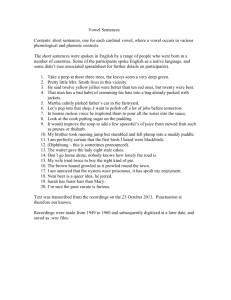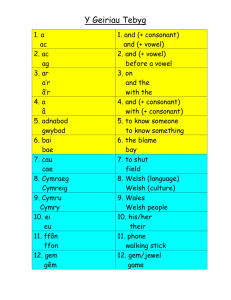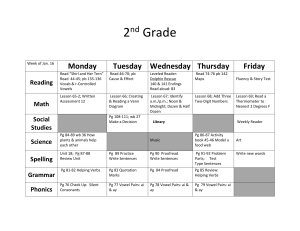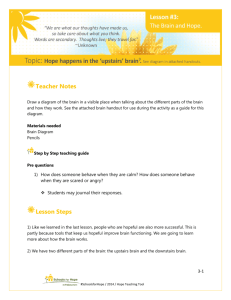Som_K_Week 2_Wilson - Veritas Classical Schools
advertisement
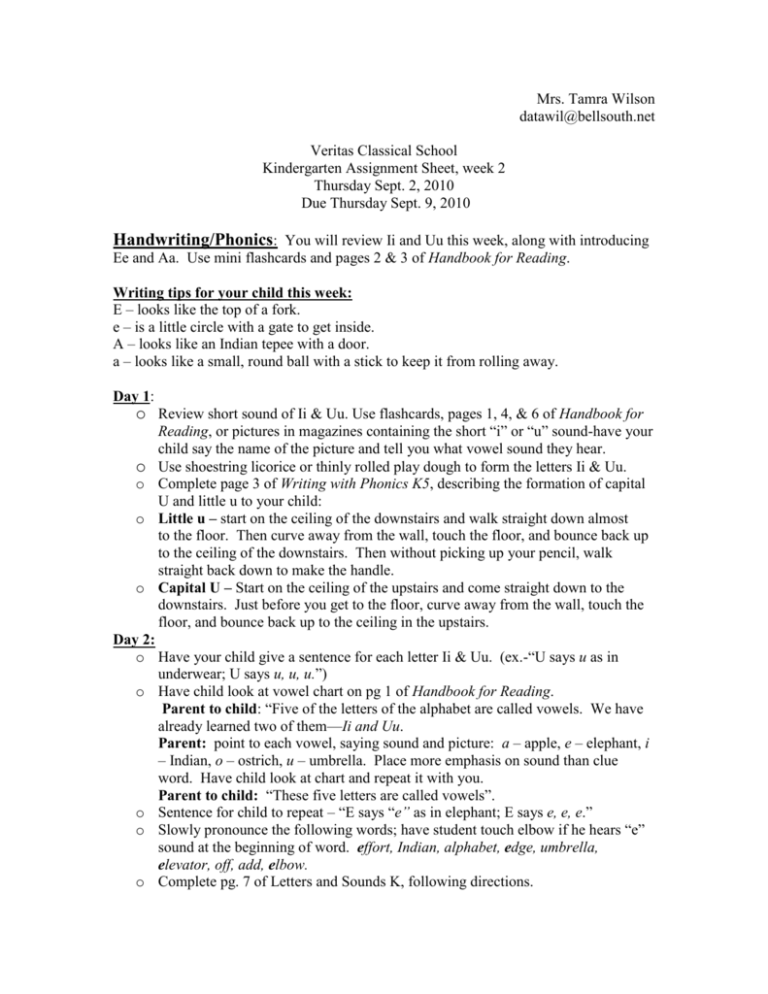
Mrs. Tamra Wilson datawil@bellsouth.net Veritas Classical School Kindergarten Assignment Sheet, week 2 Thursday Sept. 2, 2010 Due Thursday Sept. 9, 2010 Handwriting/Phonics: You will review Ii and Uu this week, along with introducing Ee and Aa. Use mini flashcards and pages 2 & 3 of Handbook for Reading. Writing tips for your child this week: E – looks like the top of a fork. e – is a little circle with a gate to get inside. A – looks like an Indian tepee with a door. a – looks like a small, round ball with a stick to keep it from rolling away. Day 1: o Review short sound of Ii & Uu. Use flashcards, pages 1, 4, & 6 of Handbook for o o o o Reading, or pictures in magazines containing the short “i” or “u” sound-have your child say the name of the picture and tell you what vowel sound they hear. Use shoestring licorice or thinly rolled play dough to form the letters Ii & Uu. Complete page 3 of Writing with Phonics K5, describing the formation of capital U and little u to your child: Little u – start on the ceiling of the downstairs and walk straight down almost to the floor. Then curve away from the wall, touch the floor, and bounce back up to the ceiling of the downstairs. Then without picking up your pencil, walk straight back down to make the handle. Capital U – Start on the ceiling of the upstairs and come straight down to the downstairs. Just before you get to the floor, curve away from the wall, touch the floor, and bounce back up to the ceiling in the upstairs. Day 2: o Have your child give a sentence for each letter Ii & Uu. (ex.-“U says u as in underwear; U says u, u, u.”) o Have child look at vowel chart on pg 1 of Handbook for Reading. Parent to child: “Five of the letters of the alphabet are called vowels. We have already learned two of them—Ii and Uu. Parent: point to each vowel, saying sound and picture: a – apple, e – elephant, i – Indian, o – ostrich, u – umbrella. Place more emphasis on sound than clue word. Have child look at chart and repeat it with you. Parent to child: “These five letters are called vowels”. o Sentence for child to repeat – “E says “e” as in elephant; E says e, e, e.” o Slowly pronounce the following words; have student touch elbow if he hears “e” sound at the beginning of word. effort, Indian, alphabet, edge, umbrella, elevator, off, add, elbow. o Complete pg. 7 of Letters and Sounds K, following directions. o Slowly sing alphabet song, pointing to each letter on an alphabet chart or on flashcards as it is sung. o Have child complete page 4 of Writing with Phonics K5, reviewing directions listed above from day 1 and writing tips from assignment sheet 1. Use a separate writing tablet for any needed extra practice. Day 3: o Have child read vowel chart, saying “A says a as in apple; A says a, a, a.” Do this with each vowel. o Pronounce following words slowly, having child tell vowel sound he hears in each word: fix, mud, dig, bus, run, lick. o Place your capital and lowercase homemade vowel cards face up on table and have child match the pairs, correctly identifying and giving a sentence for each one. o Write E & e on board or paper and ask child what each one is. Review the short sound and formations of E & e. “Down, across, across, and across again. What’s the name of this letter?” Capital E. “A small circle with a gate to get inside. What’s the name of this letter? Little e. o Sing “Be my Echo” with letter E: Parent: Be my echo Child: Be my echo Parent: E says e Child: E says e Parent: Elephant and Eskimo Child: Elephant and Eskimo Parent: Elevator, Engineer Child: Elevator, Engineer Parent: e-e-e Child: e-e-e Parent: What does E say? Child: What does E say? Parent: E says e Child: E says e Parent: Ever, exit, elbow Child: Ever, exit, elbow Parent: Echo, eggs, and engine Child: Echo, eggs, and engine Parent: E says e Child: E says e o Complete page 9 of Letters & Sounds K o Complete page 5 of Writing with Phonics K5, using writing tips listed above and these directions: Little e – Start in the middle of the downstairs just like little o. Curve up, touch the ceiling, curve down, touch the floor, curve back up, and stop before you close it up. Leave a little gate open. Go back to the starting point and close the top part with a straight stick. Capital E – Start on the ceiling of the upstairs. Make a straight stick down through the upstairs and the downstairs, and stop at the floor of the downstairs. Go back to the ceiling of the upstairs and walk out on the ceiling a little bit. Go to the middle of the stick and walk out a little bit on the ceiling of the downstairs. Go to the bottom of the stick and walk out on the floor of the downstairs just as you did on the top line. Day 4: o Warm up: slowly read words from following word list. If child hears short e, he should stand up like he is going up an elevator. If he does not, he should stay sitting in his chair. Word list: bit, led, cap, cut, men, fin, net, hop, rip, red. o Read poem: Extra! Extra! Extra! Extra! E says e. Elevator, escalator, e-e-e Elbow, Eskimo, Echo, engineer. Enter and exit right through here. Elephant, Ecuador, Extra eggs for me. Extra! Extra! I like E! o Show flashcards e, i, and u. Have child give several words that begins with each sound. Also have him give words in which sound comes in the middle. o Introduce flashcard Aa, describe using writing tips written above, and pass out slices of apples! See poem on attached page to act out while eating them! Sentence for child to repeat: “A says a as in apple, A says a,a,a.” Have child point to each one and say its correct name. (Capital A, little a.) o Write on board or paper: O A i U a A u e a Have child circle all the Aa’s. o Complete page 11 of Letters and Sounds K. o Complete pages 6 & 7 of Writing with Phonics K5. Use former writing tips and instructions to help child remember correct formations. *Remember to make sure your child has good posture with feet flat on the ground and holds pencil correctly. Day 5: o Have child review vowel chart, identification & sound of each vowel, sentence for each vowel, and name a word for each vowel. Have him match each capital & lowercase vowel card, while saying each one’s name. (this is capital A, this is little a) o Pronounce following words slowly; child tells whether he hears e, i, or u sound: o o o o bed mitt egg pup sit bug tell bill up Play What am I? game for several one-vowel objects. Tell your child clues, and when he figures out the object, have him name what vowel he hears in its name. Example: I have red and white stripes and 50 white stars. You say the pledge to me in the morning. What am I? the flag What vowel do you hear in the word flag? “a”. Repeat for other words. Review page 2 of Handbook for Reading. Place finger on arrow and slowly move it across the line as you read each picture word. This will help reinforce reading from left to right. Sing “Alphabet Song” slowly, pointing to each letter on flashcards or chart as it is sung. Complete page 8 of Writing with Phonics K5, using writing tips written above and these instructions: Little a – start in the middle of the downstairs, go up to the ceiling, bounce off, come around toward the wall (edge) of your paper, keep going until little a bounces on the floor, and come up to close the ball so carefully that you can’t even see where it closes. Then hold the ball still by standing a stick beside it. Start from the ceiling of the downstairs and come down to the floor. Just touch the ball as you go beside it. Capital A – Beginning on the ceiling of the upstairs, make a slanted stick toward the wall, through the upstairs into the downstairs, stopping at the downstairs floor. Pick up your pencil and put it on the ceiling where you started and make a slanted stick going the other way, through the upstairs into the downstairs, stopping at the downstairs floor. His belt is a straight stick right along the upstairs floor from one slanted stick to the other. **Point out typed “a” in books. Explain that letters in books sometimes look different from letters we write. Emphasize that it is the same letter and has the same meaning even though it looks a little different. Additional Optional Activities: Rhyme – Read a Nursery Rhyme to your child emphasizing the rhyming words. Repeat the rhyme, inviting your child to chime in whenever they feel ready. Ask your child to identify the rhyming words and if he can think of a different word that rhymes with the others. Do this activity daily. Listening Game – #1 Ask your child to close their eyes and listen to a sound you make (dropping a book, closing the door, clapping hands, a sneeze, a cough…) Ask your child to identify the sound, using the sentence “I heard the sound of a ______.” Next make 2 sounds at a time. “How many sounds did you hear?” “First I heard a _____, and last I heard a _____. If your child is ready, repeat the same with a series of 3 sounds. “First I heard a _____, in the middle I heard a _____ and last I heard a _____. Repeat the activity several times. #2 Collect small pictures and glue to 3x5 index cards. Use the picture cards instead of sounds to do this listening activity. Use the picture cards to have your child identify first, middle and last. Repeat the activity several times using different picture cards. #3 Say 3 words from the picture card collection. Place picture cards in front of your child. Have your child listen again, and then say only 2 of the words, removing or covering 1 of the cards. Ask your child which word is missing. Repeat this activity several times. Oral Language and Vocabulary Verbally interacting with your child simply means taking every opportunity to Talk with your child. “Wonder Statements” – Encourage your child to answer wonder statements. Say such things as “I wonder why a dog barks.” Or say, “I wonder if Grandpa likes spinach”. Rephrasing – Help your child expand his/her vocabulary by rephrasing. When your child says something such as, “He’s scared,” you could say, Yes, the dog barks because he is frightened, you are correct!” Open-Ended Questions – Instead of asking a question that can be answered with a simple yes or no, Instead ask an open ended question that will illicit a more developed answer. For example, Do not ask, “Are you raking leaves? Instead, ask “What are you doing with the rake?” Your child will answer you and then you can rephrase the answer to further develop his vocabulary. TV – Limit the amount of TV. When your child watches a children’s program, talk about it. Props – Provide household props that encourage pretend play. Use spoons, pans, cups, dolls, tools… While playing, be sure to talk through your actions. FIAR(Five in a Row) – The Story About Ping Parents: Before you begin using FIAR, please make sure you have thoroughly read the introduction and “how to use five in a row” pages in the beginning of the book. I will list the activities you are to do with your child each day, some of which will be returned in your child’s homework folder. All other activities are optional. You may even wish to extend the optional activities to the weeks no FIAR is assigned. Day 1(done in class): Social Studies – Geography – China and its Culture - We will also place the story disks on a large map each week in class. You may do your own at home for reinforcement if desired. Day 2: Literature: Fiction and the Literary Device of Repetition – Have your child make up and narrate to you a fictional story, while you write down their exact words on a sheet of paper. Encourage them to use repetition. Put this paper in the homework folder (Doesn’t have to be any certain length, 4-5 sentences is enough). Day 3: Art: Medium and Drawing Water – Put your child’s water drawing in their homework folder. Day 4: Math: Counting Skills – (Just have your child count as many as they can!) Day 5: Science: Discuss Reflection of Light. Bible Verse/Character Trait Honoring and Submitting to Authority/Responsibility Memory Verse: I Peter 2:13 – Follow the lead of every human authority. Do it because the Lord wants you to. Read the story of Jonah. Both Jonah and Ping were not where they were supposed to be, and they both find out through trying circumstances that there usually is more peace of mind and safety in doing what one is asked to do. Jonah had a responsibility to respond to God’s calling, while Ping had the responsibility to respond to his master’s call. Math: Complete Saxon K lesson & handwriting practice sheets 1-3. Counting: Children learn counting patterns when they are surrounded with a variety of counting experiences. Only through repetition and practice does the child sort out and learn the order which makes up the sequence of number words. Until a child has committed the sequence to memory, he will be unable to count objects. Rote counting is the simplest of counting concepts to learn. Practice counting by doing the following counting activities: Let’s Count to 10 ( may count to 30, if your child is ready) Let’s count to 10 starting with 1. Let’s start with 3 and count to 8. Repeat several times using a different starting and ending number. Did I Do It Right? “I’m going to count to 5: 1,2,3,4,6,5. Did I do it right? How would you count to 5? Repeat several times using numbers 1 – 10. Missing Number I will count and leave out 1 number. Which number have I left out? 1, 2, 3, 5, 6, 4, 5, 7, 8, 9 Repeat several times using numbers 1 – 10. Close Your Eyes and Jump Decide on a counting sequence ( i.e., counting from 1 to 8 or from 2 to 12). On the final number in the sequence, jump up. Critical Thinking: Mind Benders – Complete pages 3, 4, & 5. Read Aloud: Please read a rhyme, counting or pattern/repetition book to your child for at least 10 minutes each day. Books should include ones that encourage rhyme and counting skills. Your local public library should have a children’s librarian on staff. I would encourage you to take advantage of their knowledge. Sharing (Show & Tell): When your child comes back to class next week, he/she may bring an item that God made in nature, something he/she created, or a photograph. Help your child think of 3 things to say about the item. Parent’s Signature ____________________________________________________ *Remember to place these items in your child’s homework folder to return next week: o o o o o Pages 7-11 of Letters and Sounds K. Fictional story, narrated by your child, but written by you. Your child’s water drawing Both sides Saxon K sheets 1-3 This assignment sheet, signed by you for completion Do not return: o Pages 3-8 of Writing with Phonics K5 is to be kept at home. o All other work is to be kept at home for repeated use, as you will see on future assignment sheets. *I Peter 2:13 is to be memorized by your child to tell me aloud-(It is OK if they forget, but they will receive a sticker on their reward chart if they can remember the verse each week!) a-a-Apple a-a-apple in the tree. (Form large overhead circle for tree.) God made apples, and God made me. (Point to heaven; then point to self.) Pick them, wash them, peel them, too. (Pretend to pick, wash, and peel apples.) I’ll make an apple pie for you. (Pretend to use rolling pin.) Thank you, God, for fruit so sweet. (Fold hands in prayer.) a-a-apple, what a treat! (Form apple with hands.) Apples red and apples green, (Hold up one finger; then two fingers.) Apples yellow I have seen. (Hold up three fingers.) a-a-apple in the tree. (Form large overhead circle for tree.) God made apples, and God made me. (Point to heaven; then point to self.)



